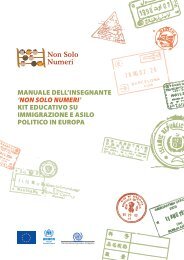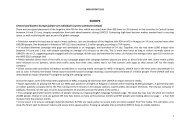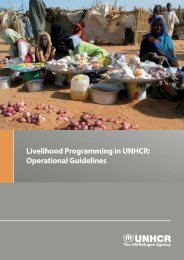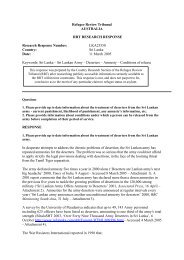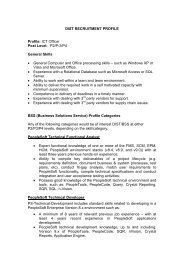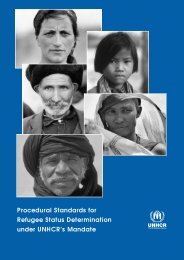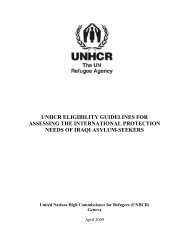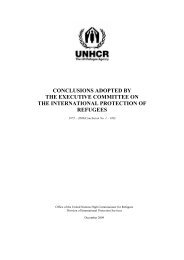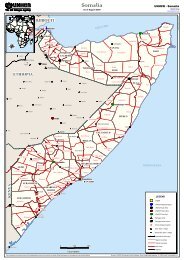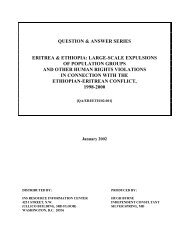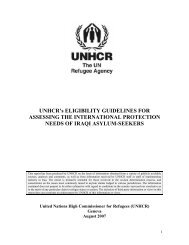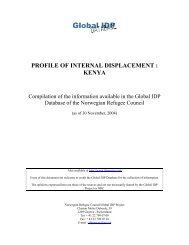The Human Rights situation of the Yezidi minority - UNHCR
The Human Rights situation of the Yezidi minority - UNHCR
The Human Rights situation of the Yezidi minority - UNHCR
You also want an ePaper? Increase the reach of your titles
YUMPU automatically turns print PDFs into web optimized ePapers that Google loves.
In addition to having <strong>the</strong> largest <strong>Yezidi</strong> population, Armenia was also <strong>the</strong> centre <strong>of</strong> Kurdish<br />
cultural production in <strong>the</strong> Soviet Union. Kurdish printing in <strong>the</strong> Soviet South Caucasus began<br />
in 1921, when a primer using <strong>the</strong> Armenian alphabet was issued from Echmiadzin; in 1929 a<br />
new Kurdish script using <strong>the</strong> Latin alphabet was introduced. 36 From 1929 many Kurdish<br />
books were printed in Armenia. Kurdish schools, teaching a full curriculum in <strong>the</strong> Kurdish<br />
language (with <strong>the</strong> exception <strong>of</strong> <strong>the</strong> teaching <strong>of</strong> Armenian) were opened.<br />
Repression began in <strong>the</strong> late 1930s. In 1938 <strong>the</strong> only Kurdish newspaper <strong>of</strong> <strong>the</strong> Soviet Union<br />
was closed; Ria taza (New Path) had been published in Yerevan regularly since 1931 and<br />
only reappeared 17 years later in 1955. 37 <strong>The</strong> Latin script for Kurdish was dropped, and<br />
instead Cyrillic script was used until <strong>the</strong> mid-1950s. In 1937 some 800 Muslim Kurds were<br />
deported from Armenia to Kazakhstan and Kyrgyzstan. 38 From <strong>the</strong> mid-1950s repression<br />
ended and <strong>the</strong>re was a Kurdish cultural revival focussed on Yerevan. “Kurdish schools” were<br />
re-introduced, albeit in just two <strong>of</strong> <strong>the</strong> republic’s districts (Abaran and Talin) and in truncated<br />
form: <strong>the</strong>se schools taught a complete curriculum in Armenian but did <strong>of</strong>fer Kurdish as a<br />
subject. 39 A Kurdish <strong>the</strong>atre was also established in 1948. 40 Significantly, academic<br />
specialists on Kurds were insiders and were able to publish regularly on <strong>the</strong> Kurds <strong>of</strong><br />
Armenia. 41<br />
<strong>The</strong> 1989 census recorded an aggregated figure <strong>of</strong> 56,127 <strong>Yezidi</strong>s and Muslim Kurds; <strong>of</strong><br />
<strong>the</strong>se 44,739 claimed Kurdish as <strong>the</strong>ir native language, while 10,415 claimed Armenian as<br />
<strong>the</strong>ir native language. <strong>The</strong>se figures do need to be seen, however, in <strong>the</strong> context <strong>of</strong> <strong>the</strong><br />
Armenian-Azerbaijani conflict, which had already begun to lead to expulsions <strong>of</strong> Azeris and<br />
Muslim Kurds in <strong>the</strong> autumn <strong>of</strong> 1988. <strong>The</strong> Nagorny Karabakh conflict and <strong>the</strong> mutual<br />
expulsions <strong>of</strong> Armenian and Azerbaijani minorities ultimately led to an estimated 18,000<br />
Muslim Kurds being displaced from Armenia, along with 186,000 Azeris. 42 Many <strong>of</strong> <strong>the</strong>se<br />
Kurds subsequently moved to Russia, probably permanently.<br />
In sum both <strong>Yezidi</strong>s and Muslim Kurds found a relative haven in Soviet Armenia, which<br />
proved to be a focal point for <strong>the</strong> Soviet Kurdish community. For Muslim Kurds, however,<br />
this haven came to an abrupt end with <strong>the</strong> onset <strong>of</strong> <strong>the</strong> Armenian-Azerbaijani conflict and<br />
displacement to Azerbaijan.<br />
36 Müller, D., <strong>The</strong> Kurds <strong>of</strong> Soviet Azerbaijan, 1920-91, Central Asian Survey, Vol. 19, No 1, 2000, p.57<br />
37<br />
Idem, p.59<br />
38<br />
Idem, p.62<br />
39<br />
Idem, p.64<br />
40<br />
Abramian, J., Background: <strong>The</strong> <strong>Yezidi</strong> Movement in Armenia, in O. Krikorian (ed.), <strong>The</strong> <strong>Yezidi</strong> Community in<br />
Armenia, p.5<br />
41<br />
Müller, p. 65<br />
42 <strong>The</strong> sources differ as to whe<strong>the</strong>r <strong>Yezidi</strong>s were allowed to self-identify as <strong>Yezidi</strong> ra<strong>the</strong>r than Kurd in <strong>the</strong> 1989<br />
census. Although some sources indicate that this was <strong>the</strong> case, disaggregated figures for numbers <strong>of</strong> <strong>Yezidi</strong>s and<br />
Muslim Kurds in Armenia in 1989 do not appear to be readily available. Ra<strong>the</strong>r, it is only <strong>the</strong> aggregated figure<br />
<strong>of</strong> 56,127 that is widely available. If <strong>the</strong> estimate <strong>of</strong> 18,000 Muslim Kurds displaced from Armenia as a result <strong>of</strong><br />
<strong>the</strong> Nagorny Karabakh conflict is correct, this would suggest that <strong>the</strong> <strong>Yezidi</strong> population <strong>of</strong> Armenia in 1989 was<br />
around 38,000. See Yunusov, A., Migratsionnye potoki- oborotnaya storona nezavisimosti [Migration flows –<br />
<strong>the</strong> flipside <strong>of</strong> independence], in R.M. Avakov and A.G. Lisov (eds), Rossiya i Zakavkaz’e: realii nezavisimosti<br />
i novoye partnyorstvo [Russia and <strong>the</strong> South Caucasus: <strong>the</strong> realities <strong>of</strong> independence and new partnership],<br />
Moscow: Finstatinform, 2000<br />
10



